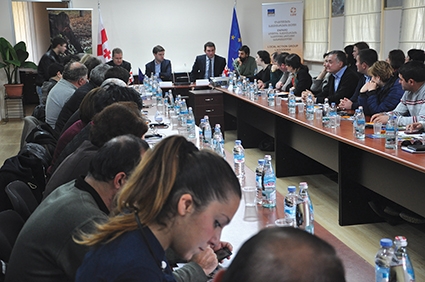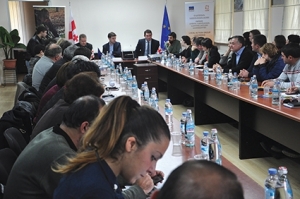EU-Funded Rural Development Pilot Project Presented in Lagodekhi
Last Thursday government representatives, local community members, and international delegates came together in the bright, day-lit conference room of the Lagodekhi Protected Area’s Administration Center to present a new pilot project aimed at spurring growth in Georgia’s rural areas.
The Lagodekhi Rural Development Pilot Project is one of a triplet of pilot projects, all formally opened at a recent launching ceremony in Stepantsminda (Mtskhet-Mtianeti region). The other two pilots are based in Borjomi and Kazbegi. Initial meetings for these pilot projects have been taking place since August.
Taken as a whole, the Rural Development Pilot Projects represent only small component of the larger European Neighborhood Program for Agricultural and Rural Development (ENPARD), a five-year program funded by the European Union which aims to “reinvigorate the agricultural sector in Georgia with a thorough cooperation of government, civil society, and farmers.” ENPARD was initiated in March 2013, and will continue until 2018. Of its EUR 52 million budget, EUR 3 million is set aside for the Rural Development Pilot Projects.
Rural Development Programs (RDPs) are a long-established and essential piece of European policy. A core aspect of these programs is the LEADER method, and its hallmark local-governance mechanism, known as the Local Action Group (LAG). The LEADER method – an acronym of “Liason Entre Actions de Dévelopement de l’Économique Rurale”, or “Links between Development Actions and the Rural Economy”, was developed in the early nineties by officials at the European Commission as a tool for spurring rural development across the newly unified Europe. It recognized the necessity of allowing rural communities to dictate the direction of their own growth, while having that growth funded by sources at the national and international level. By doing so it created early, successful examples of the public-private partnership principle, a principle now firmly enshrined in European Rural Development policy.
It is in the Local Action Groups themselves that these principles are most concretely realized. Under LEADER method, LAGs are created by the government first, with geographic boundaries drawn within which all residents are entitled to LAG membership, normally for a small fee. There is no exact requirement for the legal structure of each LAG, although they are normally organized as NGOs, but the LAG’s decision-making body must be at least 50% composed of private citizens, associations, and business interests. Therefore, it is hoped that it is the private interests of the local community itself which come to determine the direction of the LAG, which itself is responsible for distributing the Rural Development funds allotted to it by the public, government budget.
RDPs and the LEADER method have been implemented across the European Union for nearly two decades, and are being expanded into new Member States. For instance, in February of this year the European Commission approved a second RDP for Slovenia. A EUR 1.1 billion public budget is available for the 7-year period, of which EUR 838 million is coming from the overall EU budget. The RDP as adopted anticipates nearly 600 jobs created in rural areas.
The Rural Development Pilot Projects in Georgia are funded as a part of the EU’s European Neighborhood Policy, which is concerned with the EU’s nearby “Neighbor” states – hence the name of the larger ENPARD programme of which these three pilot projects are a part. Each pilot project community is to be paired with NGOs and organizations from communities where the RDPs are already in place.
In Lagodekhi, the pilot project is to be implemented with the assistance of the international NGO CARE, in partnership with the ETEA foundation, a university center based out of Cordoba, in southern Spain.
Accordingly, present at the opening presentation last Thursday were representatives and delegates from across Europe. Filling the room before the head panel were dozens of government officials and local community members. There was a clear sense of eagerness, of reigned-in and cautious enthusiasm. “Potential” was the keyword of the afternoon, gushed both as regards the LEADER method as a tool and Lagodekhi as a testing grounds for it in Georgia.
The Govenor of Lagodekhi Municipality, Kakha Jamburia , started with a call to action for his neighbors. “We are here to strive and walk together. We have to be proactive and develop a correct strategy. We will be a model and example for others.”
One official from the Ministry of Agriculture spoke up towards the end of the proceedings. “One week ago I visited Slovenian villages with the same project,” she said. “I would like to assure you that it can be very successful. Yes, financial support is important, but your support is even more important. I had the impression the villages had been painted by an artist. They don’t need an outsider to tell them what to do. I invite you to forget your ego – and to think about your village. This is a unique opportunity from EU and CARE, but don’t forget that they will leave, and we will stay. Please, all of you, be involved, be proactive, and we will see amazing, amazing results, too.”
Robert Isaf











